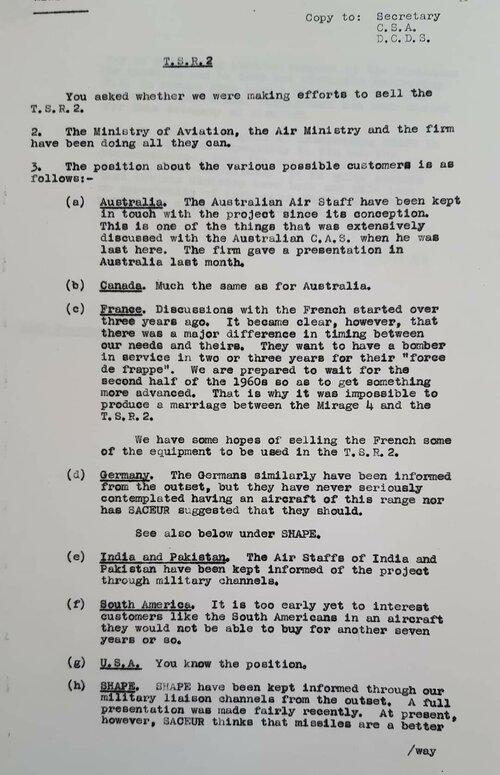Yellow Palace
ACCESS: Top Secret
- Joined
- 5 May 2007
- Messages
- 1,146
- Reaction score
- 1,977
The possibility of the UK avoiding the 1965 aircraft cancellations has been discussed ad nauseam. I don't propose to get into it here - assume a collective delusion of the UK government, the discovery of a massive gold deposit, or intervention from extra-terrestrial intelligences, as you see fit.
What I don't think has been discussed, particularly, is the impact on the rest of the world. The cancellations led to some new types, which wouldn't come into being in this scenario.
A surviving TSR.2 is, it's safe to assume, a dead duck on the export market. Nobody else would buy the thing; the only vaguely plausible export candidate was Australia, and they preferred the F-111 even before the cancellation. But if the UK is building TSR.2, it probably doesn't have any interest in the Multi-Role Aircraft consortium being put together by NATO countries to replace the F-104. That means the UK isn't there as a driver for the bigger, more complicated Tornado we know. There's a reasonable chance that keeps the Netherlands in the project. It might keep Canada in. It probably won't keep Belgium in. Export sales of the alt-MRCA could go either way: the Saudi contract is probably dead (no idea what they're buying!) but it might get some more F-104 replacement orders in place of the F-16.
A surviving P.1154 similarly kills the Jaguar. France gets its supersonic trainer and light attack aircraft without the RAF driving up the size and complexity. Best guess for the export orders is a couple more notches on the Mirage 5's belt. It also kills the Harrier as we know it. A Sea P.1154 (probably still Harrier, but clarity is needed) might come about for the INVINCIBLE class, but that's a bigger, heavier type again. Might be a more difficult sell politically. If it does come along, the Indian Navy might still buy them. Would the USMC be interested in a supersonic STOVL aircraft, noting that it's considerably bigger than the A-4? If not, the Spanish and Italian Harriers won't happen. We can probably rule Thailand right out. Maybe the USMC keeps looking, maybe it keeps the A-4 going, maybe it buys the A-7.
The HS.681... might make a few impressive displays at airshows. But I doubt very much it's going to meaningfully impact anything. Anyone with any sense is still buying C-130s.
What I don't think has been discussed, particularly, is the impact on the rest of the world. The cancellations led to some new types, which wouldn't come into being in this scenario.
A surviving TSR.2 is, it's safe to assume, a dead duck on the export market. Nobody else would buy the thing; the only vaguely plausible export candidate was Australia, and they preferred the F-111 even before the cancellation. But if the UK is building TSR.2, it probably doesn't have any interest in the Multi-Role Aircraft consortium being put together by NATO countries to replace the F-104. That means the UK isn't there as a driver for the bigger, more complicated Tornado we know. There's a reasonable chance that keeps the Netherlands in the project. It might keep Canada in. It probably won't keep Belgium in. Export sales of the alt-MRCA could go either way: the Saudi contract is probably dead (no idea what they're buying!) but it might get some more F-104 replacement orders in place of the F-16.
A surviving P.1154 similarly kills the Jaguar. France gets its supersonic trainer and light attack aircraft without the RAF driving up the size and complexity. Best guess for the export orders is a couple more notches on the Mirage 5's belt. It also kills the Harrier as we know it. A Sea P.1154 (probably still Harrier, but clarity is needed) might come about for the INVINCIBLE class, but that's a bigger, heavier type again. Might be a more difficult sell politically. If it does come along, the Indian Navy might still buy them. Would the USMC be interested in a supersonic STOVL aircraft, noting that it's considerably bigger than the A-4? If not, the Spanish and Italian Harriers won't happen. We can probably rule Thailand right out. Maybe the USMC keeps looking, maybe it keeps the A-4 going, maybe it buys the A-7.
The HS.681... might make a few impressive displays at airshows. But I doubt very much it's going to meaningfully impact anything. Anyone with any sense is still buying C-130s.

